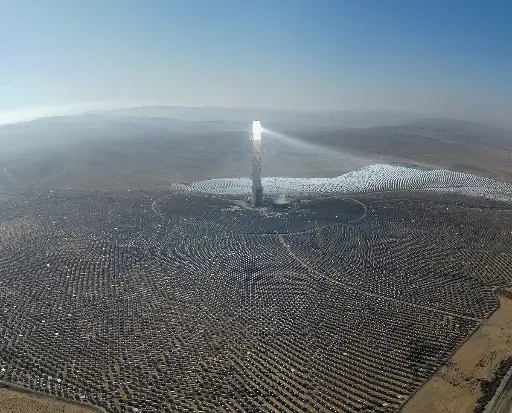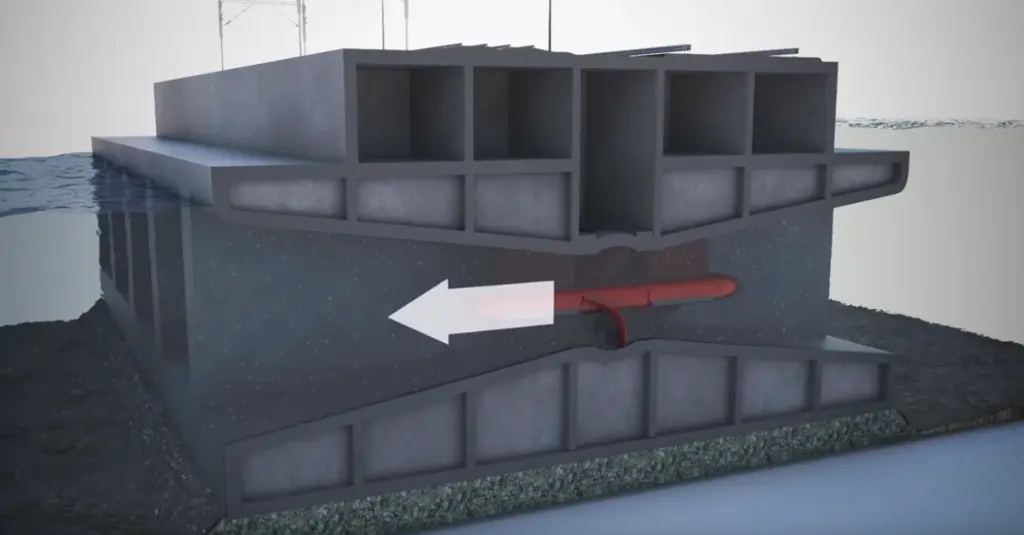Everyone knows solar, wind, and hydropower. Geothermal and biomass are also typically well-known, although maybe in less detail. Fremsyn’s affiliated gas trading, Biogem A/S, is all about supporting biogas plants from design to certification and supply. But there are many specific renewable energy production technologies that remain slightly obscure to the general public. Without going too deep into the theory, let’s dive into the ideas behind those.
A. Tidal power
A pretty relevant topic to dive into, right? The ocean is vast and holds immense energetical potential. Tidal power harnesses the ceaseless movement of the ocean’s waters to generate electricity. One of the main methods involves tidal barrages where dams are installed across coastal estuaries to capture the tides as they come and go. When tide flows in, gates open, turbines turn, and the barrage fills up. Then gates close, and the stored water is released, driving the turbines according to the demand. Overall, this is very close to river-based hydropower, but with clear phases. To allow for a similar technology alongside coasts rather than estuaries, a T-shaped protrusion from the coast can be built, creating a tide differential between both sides, generating a flow activating turbines.
Another approach, the tidal stream system, drew its inspiration from marine ecosystems, deploying turbines that act like aquatic windmills. They are spun by the strong tidal currents, thus generating electricity. The main downsides to tidal power are its environmental impacts on marine habitats, their limited location suitability, and their high initial costs and lengthy planning. An important issue that can arise is siltation, meaning the accumulation of sediments reducing their effectiveness.
B. Wave power
The term “wave power” actually encompasses an array of very different technologies with the common goal of, somehow, using waves to generate electricity. A particularly promising one is the oscillating water column (OWC), consisting of partially submerged chambers with a roof. When a wave reaches the system, water fills the chamber, pushing the air out, which in turn activates a turbine. This system is relatively robust and straightforward, making it suitable in many areas. It can however easily interfere with marine life, trapping organisms inside, or creating noise pollution for it being alike a large whistle.
Another approach is to use point absorber devices, involving floating buoys bobbing up and down with the waves. As these are tethered to the seabed by hydraulic pistons, they drive hydraulic pumps converting the motion into electricity. They are usually quite versatile and resilient.
In addition to these stand attenuators, also known by the more interesting name of wave snakes. They are long and segmented structures that float at the surface and bend with the uneven edges of waves. Again, this drives hydraulic mechanisms, generating electricity.
One last type of system involves panes or flaps with a base attached to the seabed, going back and forth with the waves. The rocking motion drives a linear hydraulic system, generating electricity.
Like with tidal power, wave systems can interfere with marine ecosystems and need specific conditions. Additionally, as can be guessed with the number of different technologies available, there is no general agreement on the ideal wave system, showing that the technology still isn’t fully mature.
C. Ocean thermal energy conversion
The ocean surface is typically quite a bit warmer than its depths, and this temperature difference can also be harnessed. The thermal gradient allows the generation of electricity by using a system of pipes to pump surface water and cold seawater up to the surface into a heat exchanger. The warm water boils a working fluid such as ammonia, which expands, drives a turbine, and gets condensed back by the cold water. The main advantage of this technology is its potential for continuous generation, while many renewables are intermittent. Unfortunately, its disadvantage is its low efficiency, as it currently proves advantageous mainly in tropical and subtropical areas, where the temperature difference is large. Even so, it holds as one of the main contenders for being a significant driver of the transition to clean and renewable energy as technology advances and costs decrease.
D. Osmotic power / Salinity Gradient Power
You might remember how the water cycle goes: rain and melting snow result in rivers, flowing down until eventually reaching seas and oceans. However, oceans are salty, while rivers are not. And believe it or not, when putting saline water next to fresh water, separating them with a membrane that only allows water molecules to go through, the fresh water will try to flow into the saline water to dilute it. Picture it as a difference of potential, here being a difference in salt content. Then, as with any flow, you can find a way to gain energy from it, most commonly with turbines. This idea has been coined under the term of pressure-retarded osmosis, and some plants are already using it, pumping both fresh and sea water in estuaries to harness the osmotic pressure. Membrane technology is unfortunately expensive and energy intensive, so these systems do not boast the highest efficiencies. Additionally, as can be guessed, they require various permits and full compliance with numerous regulations.
E. Rain power
If photovoltaic can generate energy when the weather is good, why couldn’t we do the same when the weather is bad? Rain is one of the obvious forces of nature we still haven’t found an efficient way to harness the power of. Many approaches have been considered: collecting rainwater to power small hydro turbines, using piezoelectric materials that generate some electricity when in motion, and more recently using a device called a triboelectric nanogenerator (TENG), creating electricity from liquid-solid contact. The basic principle of the latter is that raindrops slide on a panel with a different affinity for electrons, exchanging them and giving both sides a small electric charge, thus creating an electric field, and when crossing a linear electrode, the field allows for a flow of electrons in the material, which is precisely electricity. Harnessing energy from rain still is a nascent concept, but it might become a fully relevant technology.
F. Wind kites
Yes. Seriously. Kites. Also known as airborne wind energy, its principle is very simple: Huge kites tethered to cables can soar through the skies and capture strong winds, unwinding the cables which in turn activate a generator on the ground. Specialised aerofoils generate lift and help the kite to fly in a figure-eight pattern to increase its unwinding time and provide a continuous and consistent motion. The system is designed to maximise its exposure to strong winds, and once max length has been attained, a winch pulls the kite back quickly, consuming significantly less energy than was produced during flight. Then, a new cycle begins. This has the advantage of being a quite cheap source of power, both in financial and material terms. Although the system itself is quite small for its power output, it requires an empty flight zone and thus has relatively large space requirements.
G. Concentrated solar power
Photovoltaic panels are not the only way to get electricity from the sun, and this one looks cooler. Vast fields of mirrors, shimmering under the sun’s intense rays, harness its power by sending it to a high central tower. The mirrors, known as heliostats, are positioned to reflect sunlight hitting a wide area and concentrate it onto a single focal point where sits a receiver converting this power to warm up a storage material, accumulating heat up to 600ºC. The material often is either molten salt or synthetic oil. This heat can then generate steam, used in a conventional turbine generator to produce electricity. The big advantage of this system compared to solar panels is its inherent energy storage ability, allowing for electricity generation for some time under cloudy conditions or at night. Additionally, the very high temperatures reached by this technology also allows it to be used for industrial applications instead of – or alongside – electricity generation.

Other similar methods involve mirror-lined parabolic troughs concentrating sunlight along a central tube containing the heat transfer fluid, linear Fresnel reflector systems which are a mix between the two (involving flat mirrors reflecting sunlight onto one large tube), and unitary parabolic dishes activating a Stirling engine.
H. Specific biofuel technologies:
Most people are aware that utilising biomass for energy is a thing, most obviously with wood-fired systems, and recently with biodiesel and ethanol production, but there are some additional pathways that usually do not get the spotlight:
a. Hydrothermal Liquefaction
At its core, HTL is a thermochemical conversion process, mimicking what happened to dinosaurs when natural geological processes turned them into crude oil. However, instead of taking millions of years, HTL happens in a matter of hours, using high temperature and pressure to convert algae, residues, sludge, organic waste and even some plastics into bio-crude oil. Its perks are many, as it offers a novel solution for waste management and valorisation, mitigating the environmental burden of landfilling and incineration, all while alleviating pressure on crude oil use. Biocrude can then be refined into a range of fuels and chemical, effectively providing an alternative to oil for most of its uses. However, it also comes with its lot of drawbacks, the main one being its high requirements in energy to provide sufficient heat and power, limiting the overall efficiency of the process. There are also some challenges related to wastewater management, product stream consistency, and generation of harmful compounds during combustion. Despite these, and alongside biogas trucks, HTL stands as one of the main envisioned pathways to reduce the environmental impact of transportation, still hugely dependent on liquid fuels.
b. Gasification
A similar idea, but with different inputs and outputs. Gasification involves subjecting feedstocks such as biomass, coal, and waste to high temperatures and controlled amounts of oxygen. This breaks down the matter into its basic molecular components, primarily carbon monoxide, dihydrogen, and methane, along traces of other gases. The resulting syngas can be used as a precursor to a wide array of products, as CO and H2 can be compared to the Lego blocks of organic chemistry. Additionally, hydrogen can be used for energy as is, or synthetic diesel can be produced, reducing our dependence on conventional oil. However, as gasification is a technically challenging process, it struggles to reach widespread adoption and technological maturity.
c. Pyrolysis
Third of the thermochemical triplets, pyrolysis happens at high temperatures in an oxygen-deprived environment, in a sealed reactor. As the feedstock heats up, it undergoes thermal decomposition, breaking down into solid char, liquid bio-oil, and multiple gaseous products. The biochar can be used as soil amendment to improve the health of cultivated land and sequester carbon in the ground, while the bio-oil and syngas can be used as described above. Unlike simple combustion, pyrolysis retains a significant portion of the energy stored in the feedstock by keeping it in the oil and syngas. However, it faces similar issues as its sister technologies, and biochar has to meet strict quality standards to be used in soil.
That was a lot! Of course, these were only tiny
introductions to the topic, so feel free to look them up online if you wish to
learn more! Most of the renewable energy generation processes widely accepted
as potentially relevant have been covered here, but there are also some lesser-known
energy storage technologies that deserve some attention, and these will
be covered in a later article! In the meantime, Fremsyn remains a go-to partner for matters related to biogas, so feel free to browse what we have to offer!




Lesser-known renewable energy generation methods